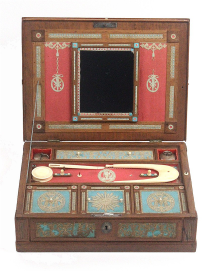
Pin Boxes and Cushions
Pins are objects today that we take for granted, but have existed since man first walked the earth, when they were fashioned from thorns, fish bones or simply carved from wood. As metals were developed, starting with bronze, so the pin developed. Its manufacture and design thereafter became increasingly complex and its unit cost fell. Pin themselves form a collecting field, from early Egyptian, Saxon, Roman and medieval pins through to pin papers - a sheet of paper neatly laid out with rows of pins that were given as change for small amounts of money, giving rise to the term 'pin money', i.e. a very small amount. In the early years of pin production, centres of manufacture developed and these were often fiercely protected by guilds or Royal decree. Pins were used not so much for needlework, but for securing clothing and it was inevitable that containers of all sorts would be developed. The range of pincushions, boxes and pin cases is too vast to examine in any detail here, but it is one of the most popular fields of collecting, the variety being almost endless, with novelties of any type being produced by the needlewoman herself, as well as the specialist maker.







